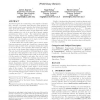Free Online Productivity Tools
i2Speak
i2Symbol
i2OCR
iTex2Img
iWeb2Print
iWeb2Shot
i2Type
iPdf2Split
iPdf2Merge
i2Bopomofo
i2Arabic
i2Style
i2Image
i2PDF
iLatex2Rtf
Sci2ools
PODC
2009
ACM
2009
ACM
Max registers, counters, and monotone circuits
A method is given for constructing a max register, a linearizable, wait-free concurrent data structure that supports a write operation and a read operation that returns the largest value previously written. For fixed m, an m-valued max register can be constructed from one-bit multi-writer multireader registers at a cost of at most lg m atomic register operations per write or read. The construction takes the form of a binary search tree: applying classic techniques for building unbalanced search trees gives an unbounded max register with cost O(min(log v, n)) to read or write a value v, where n is the number of processes. It is also shown how a max register can be used to transform any monotone circuit into a wait-free concurrent data structure that provides write operations setting the inputs to the circuit and a read operation that returns the value of the circuit on the largest input values previously supplied. The cost of a write is bounded by O(Sd min( lg m , n), where m is the si...
| Added | 25 Nov 2009 |
| Updated | 25 Nov 2009 |
| Type | Conference |
| Year | 2009 |
| Where | PODC |
| Authors | James Aspnes, Hagit Attiya, Keren Censor |
Comments (0)

